The first seven permanent outdoor sculptural installations that will rise along Destination Crenshaw, a Black cultural corridor now underway in South Los Angeles, have been approved by L.A.’s Cultural Affairs Commission. The announcement marks a major milestone for the future open-air art museum-slash-community hub that is set to transform a 1.3-mile-long stretch of Crenshaw Boulevard in the Hyde Park and Leimert Park neighborhoods. Here, a total of 100 Black artists in all stages of their respective careers will eventually be tapped to create new public artworks in what is the largest-ever art commissioning initiative for Black artists in the United States. First announced in early September, the inaugural cohort of Destination Crenshaw artists includes Charles Dickson, Melvin Edwards, Maren Hassinger, Artis Lane, Alison Saar, Kehinde Wiley, and Brenna Youngblood.
Established as a $100 million public-private public space and arts initiative celebrating the Black Angeleno community, Destination Crenshaw features a trio of key players on the design front: Perkins&Will, the National Design Award-winning Studio-MLA, and museum design and planning firm Gallagher & Associates. These three practices are leading the project’s architectural/streetscape design, landscape design, and storytelling elements, respectively.
In addition to the seven leading artworks approved by the city, Destination Crenshaw also announced earlier this week that it has now amassed a total of $61.5 million in private and public funding, including a recent $3 million grant commitment from the Getty Foundation. As further detailed in a press release, this funding will help to kick-start a larger partnership between the Foundation and Destination Crenshaw and support the commissioning, fabrication, and installation of the corridor’s commissioned public artworks. The Getty Conservation Institute will also advise on a conservation and maintenance plan of said public artworks. What’s more, Getty’s support will also include the establishment of a youth internship and apprenticeship program while joint public programming is developed around the commissioned art by Destination Crenshaw and the African American Art History Initiative of the Getty Research Institute.
Referring to Destination Crenshaw as a “fitting and joyful tribute to Black creativity and history, combining a high level of artwork, urban design, and landscape design with targeted economic investment and community engagement every step of the way,” Getty Foundation director Joan Weinstein said in a statement that although the initiative is “unique in location and scope,” it can also “serve as a model for other communities throughout the country.”
In a conversation with AN last year, architect Zena Howard, who serves as the cultural practice leader and managing director of Perkins&Will’s North Carolina practice, explained:
“There really isn’t a true precedent for this. There are some projects that are in the same ilk—people cite the High Line and other things—but there are none that tell a consistent story that had not really been put forth, and that are community-driven and inspired in the way that this is.”
Four of the newly approved permanent sculptures—those by Dickson, Hassinger, Lane, and Wiley—will be installed at Sankofa Park, which will serve as the northernmost public space of Destination Crenshaw at 46th Street and Crenshaw Boulevard. The anchoring park is straddled by a large overlook structure with a form inspired by the symbol of the mythical Sankofa bird, which flies forward while also looking backward. Also just-announced, NBA superstar DeMar DeRozan of the Chicago Bulls, a native of Compton, will provide leadership support for the Sankofa Circle fundraising group, which provides “high-level naming opportunities” for Sankofa Park.
On the southern end of Destination Crenshaw, near Slauson Avenue at Welcome Park and I AM Park, will be the commissioned works by Alison Saar and Brenna Youngblood, respectively. The sculpture by Melvin Edwards will be installed roughly midway along the corridor at 54th Street.
“We’re thrilled by the enthusiastic support the City of Los Angeles has given our plans to strengthen the community by installing these exceptional works, whose artists have been nurtured and inspired by the Crenshaw neighborhood,” said Destination Crenshaw president and chief operating officer Jason W. Foster in a statement. “We express our deep gratitude to the Getty Foundation and all our generous donors for committing themselves to this community-led project, which we initiated with the conviction that residents of one of the world’s largest and most creative Black neighborhoods deserve to live in a beautiful, green, artistically impressive and economically strong environment.”
Below is a look at each of the seven newly city-approved inaugural works, moving north to south along the corridor, with descriptions of each provided by Destination Crenshaw.
Car Culture by Charles Dickson (Sankofa Park)
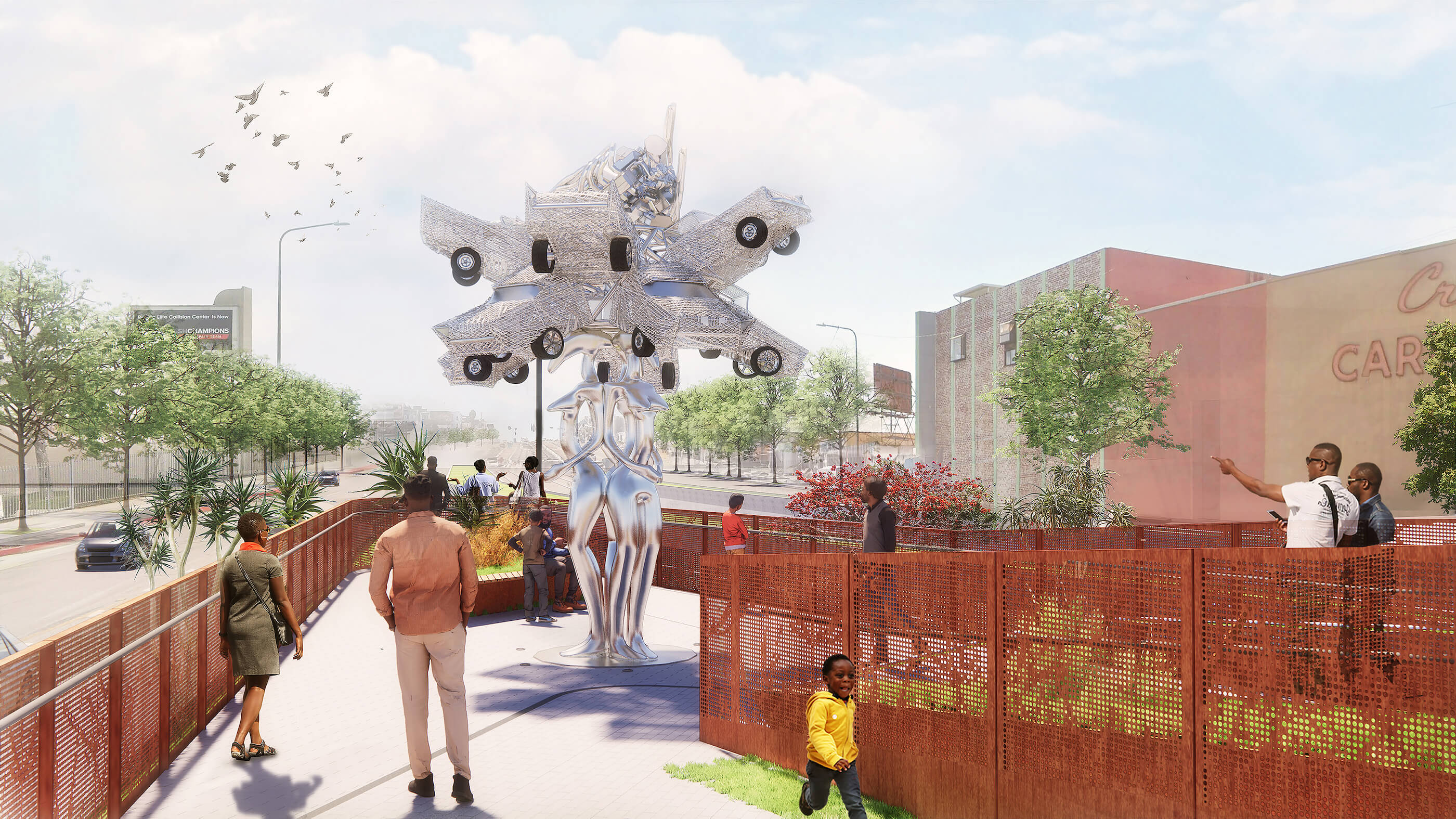
This sculpture “expresses the confluence of spirit, place, and intention in Black life in Los Angeles, where cars rather than the Sankofa bird symbolize mobility. Cars are fundamental to Crenshaw’s communal street life, and Car Culture incorporates elements of the cars that might be seen when the low riders gather in Leimert Park. The sculpture’s main body is a trio of elongated figures resembling West African Senufo ritual objects, which are the conduit between the living and spirit worlds. Adapting this idea, Dickson uses fiber optic cables to connect these figures—larger-than-life portals to the past—with their crowns, which are fashioned from the fronts and ends of cars. Atop these car parts rests a fanciful engine, a symbol of our capacity to engineer our futures by sustaining a relationship with the vitality of the past.”
An Object of Curiosity, Radiating Love by Maren Hassinger (Sankofa Park)
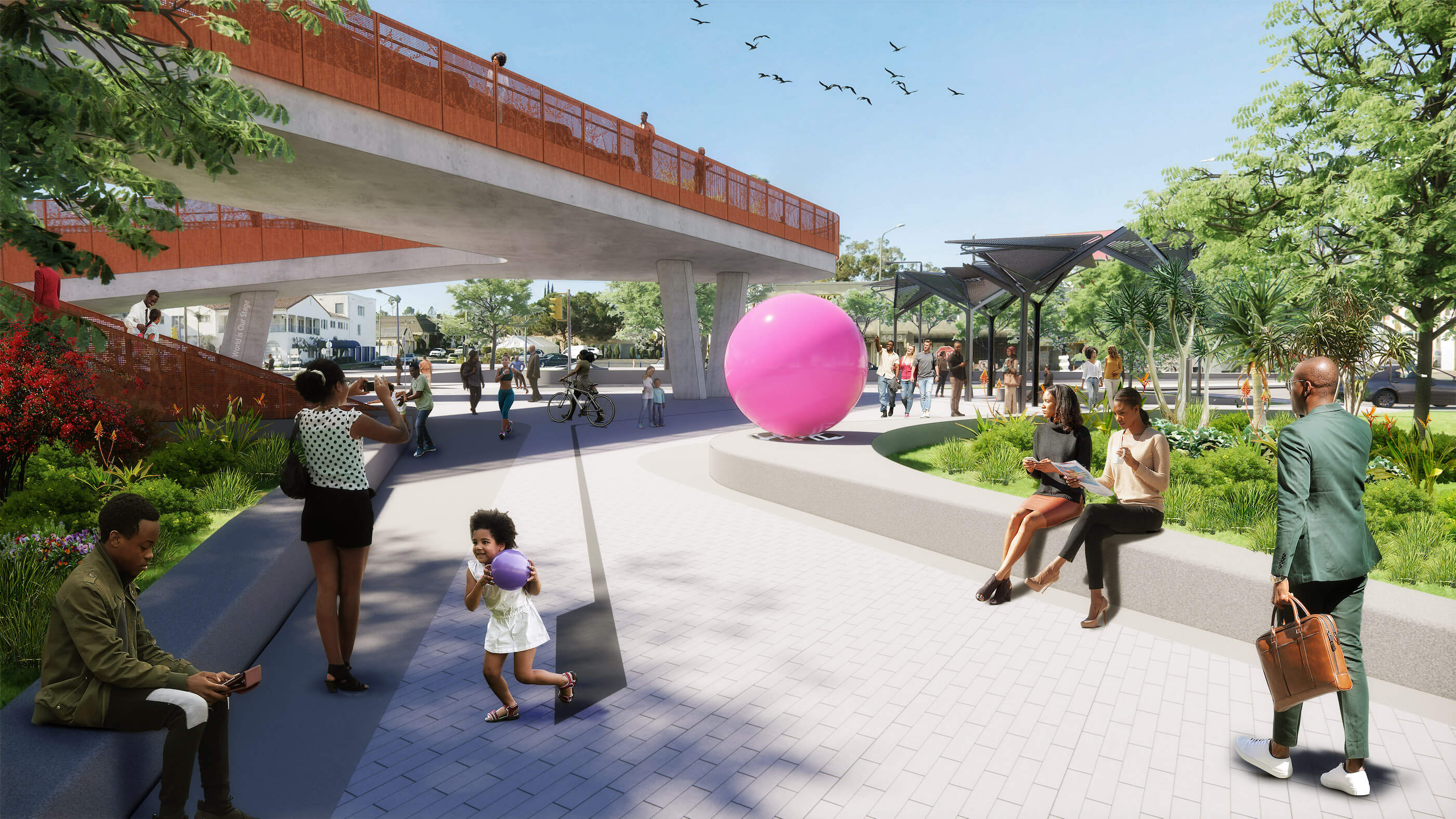
“Maren Hassinger often works with unconventional materials such as plastic bags, tree limbs, and leaves, inviting viewers to engage with the stories she tells through material and form. An Object of Curiosity, Radiating Love, is a large pink fiberglass orb, 6 feet in diameter, which glows with a soft pink when viewers approach it. It is the most conceptually abstract of all Destination Crenshaw’s permanent commissions, yet it may also be the most accessible because of the visceral impact of its interaction with people, which enables them to feel they are communicating with it. Encountered in Sankofa Park’s communal space, the sculpture is a symbol of the love that members of the community need if they are to be in service to one another, resisting gentrification and erasure.”
Emerging First Man by Artis Lane (Sankofa Park)
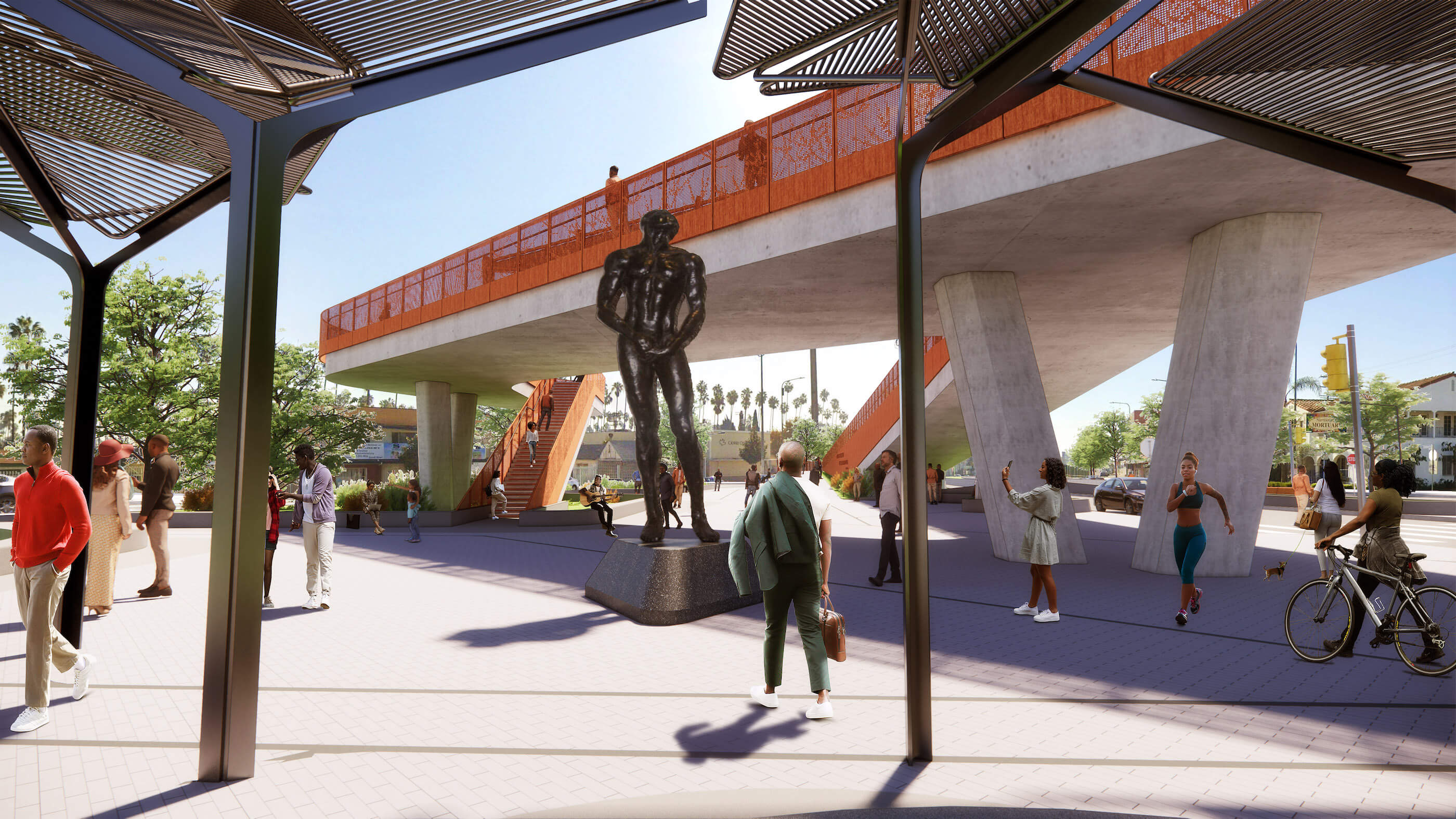
“Artis Lane considers the figure of the Black man to represent universal humanity, which experiences struggles and achievements as it undergoes a transformation into awareness. For the Sankofa Park site, the artist uses her Emerging into Spirit concept to engage with the Crenshaw neighborhood as a site of discovery, communion, opportunity, and growth. Emerging First Man is a larger-than-life bronze figure that bears on its surface the casting materials from the foundry where it was made, symbolizing a physical and spiritual birth into an understanding of purpose and possibility. It is conceived as a beacon of hope, reminding the community that we are all in the act of becoming, with our human experiences moved by divine intentions that enable us to be our best selves.”
Not yet titled work by Kehinde Wiley (Sankofa Park)
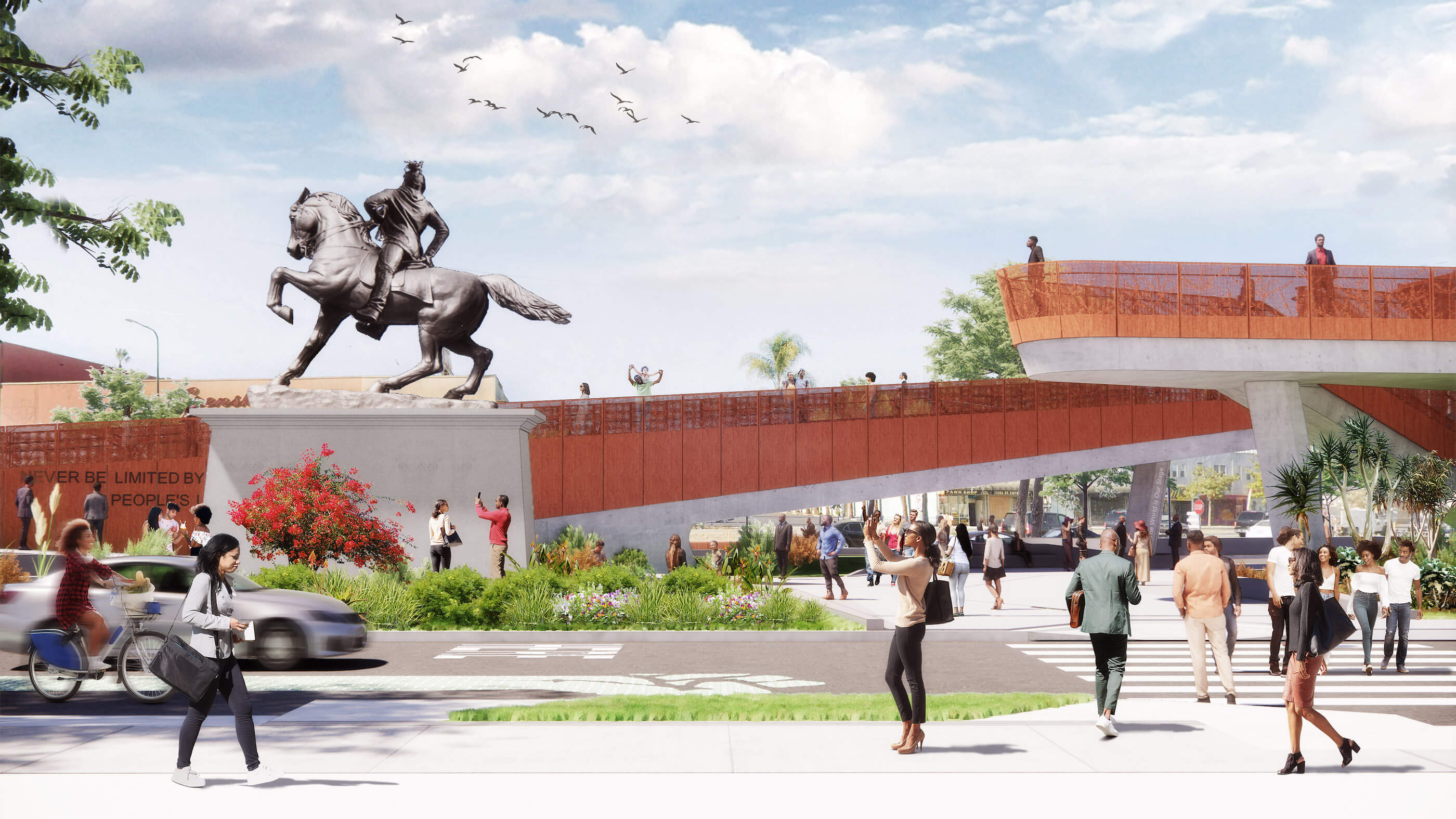
“Kehinde Wiley’s sculpture is of a young, West African woman, rising up from the streets of Crenshaw Boulevard and Leimert Park. She will stand as a corrective, artistic intervention and a code switch. She is positioned like the Sankofa figure, moving forward and embracing the past as a function of a much broader and inclusive worldview to strengthen the ongoing legacy of the neighborhood. This is Wiley’s first large public sculpture featuring a woman on horseback. Wiley empowers her to stand as an indictment of the ways in which African women have traditionally been viewed.”
Column by Melvin Edwards (54th Street)
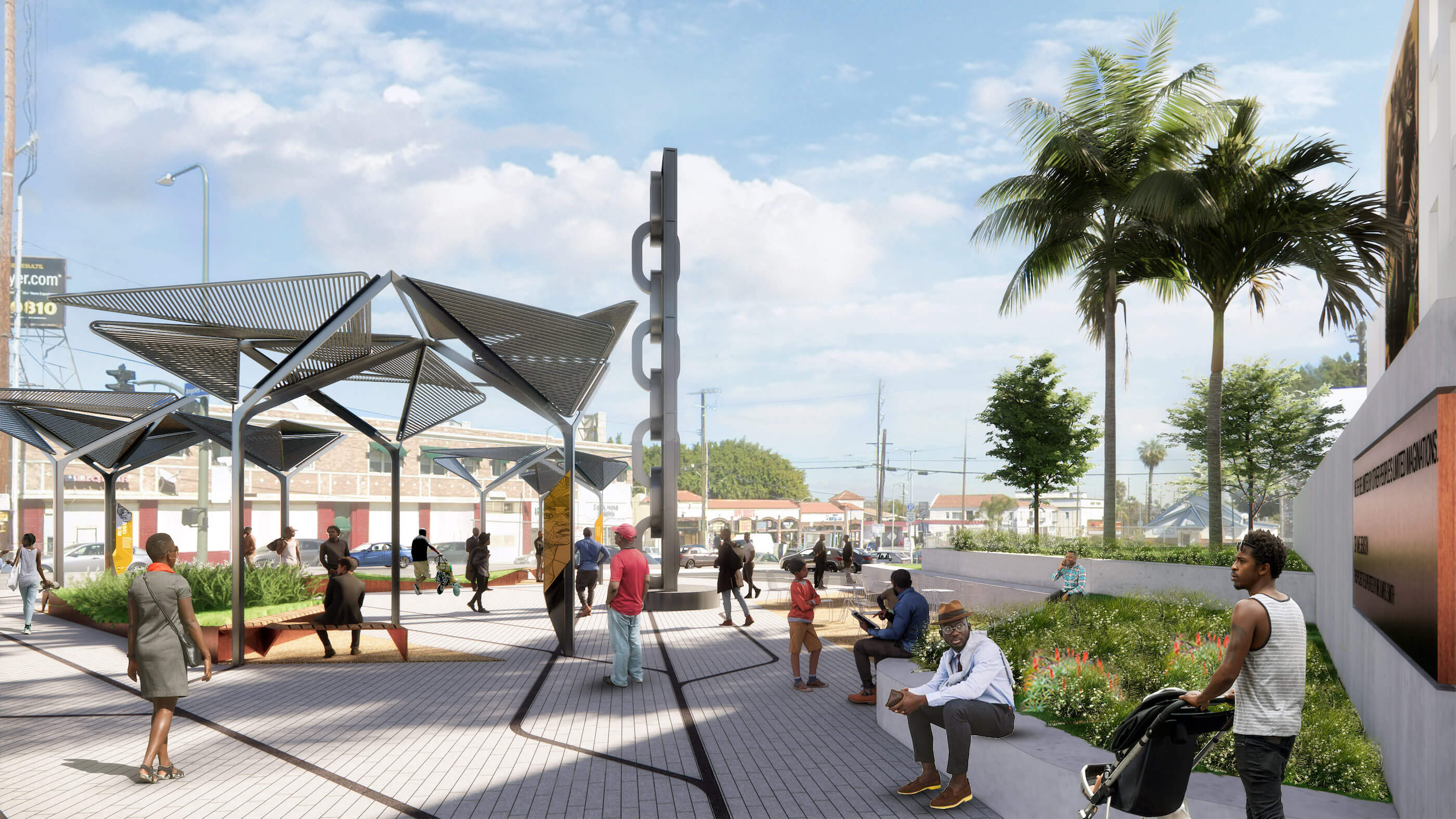
“Throughout his career, Melvin Edwards has been interested in chain links as a material that can tell stories about connection and community. In works installed throughout the United States, as well as in Cuba, Brazil, and Senegal, he has used chain as a stand-alone element, expressing collective unity, resistance, and the fortitude not only to endure but to thrive. Column, rising to a height of more than 36 feet, is his largest chain work to date. Its surface of burnished stainless steel reflects the community in which it stands and with it the residents’ generative legacy of cooperation and innovation. The verticality of the chain represents how our stories build upon another, how we stand on the shoulders of those who came before us, and how our collective engagement becomes the structure for our own success.”
Bearing Witness by Alison Saar (Welcome Park)
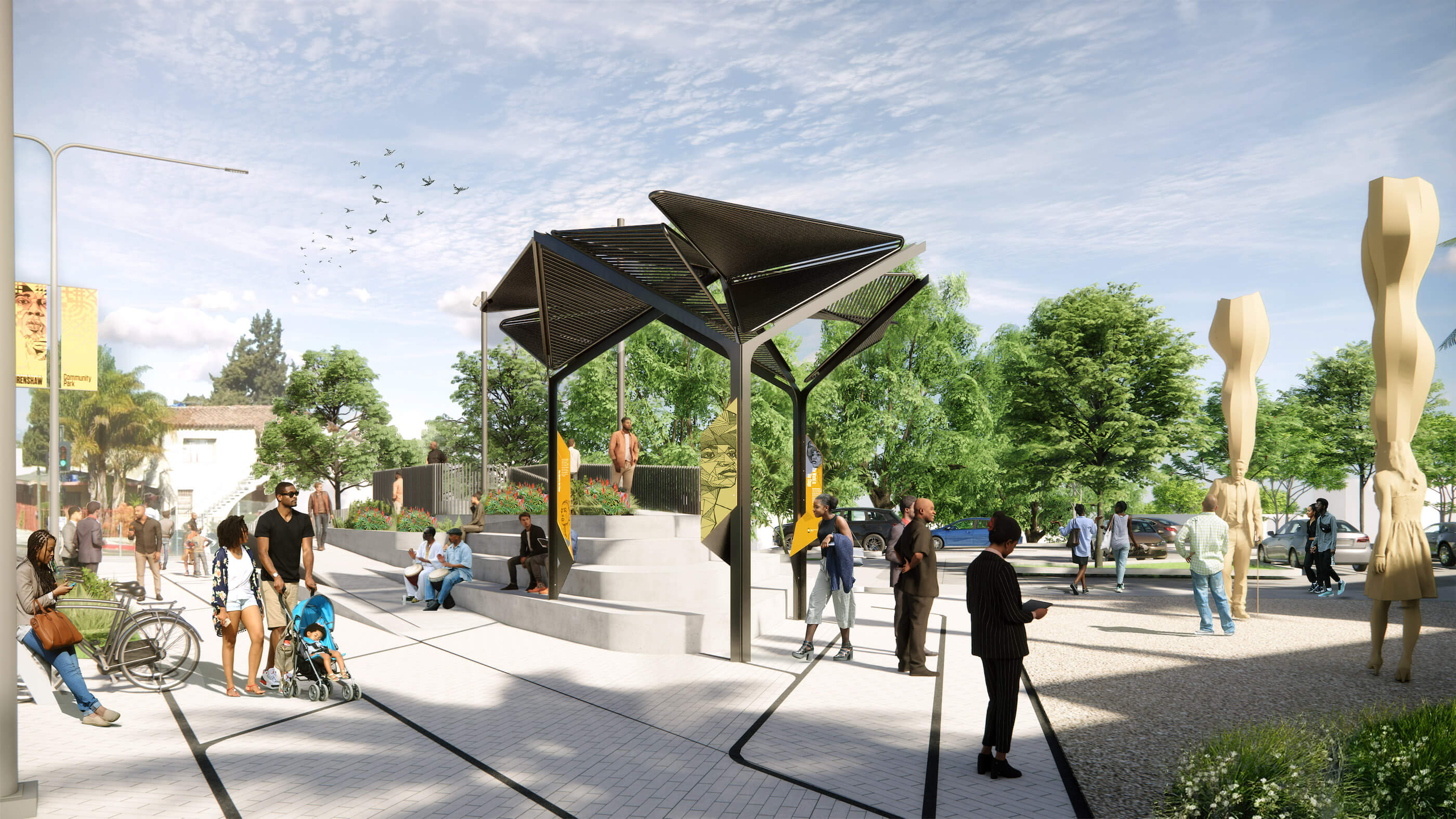
“Alison Saar honors the past, present, and futures of Crenshaw with Bearing Witness, an installation of two 13-foot-tall bronze figures, one female and one male, facing one another at a crossroads of the Boulevard. In a continuation of her use of “Black hair” as a potent visual language, the artist has fashioned the enormous coiffures of the two figures out of everyday objects culled from local thrift stores. Cast in bronze, these objects represent the art, music, and literature that make Crenshaw a destination. Carrying these symbols of the community in their hair, the two figures become an architecture of human labor and innovation and like the poteau-mitans of Haitian Vodou are conduits for the spirits to descend and interact with the faithful.”
I AM by Brenna Youngblood (I AM Park)
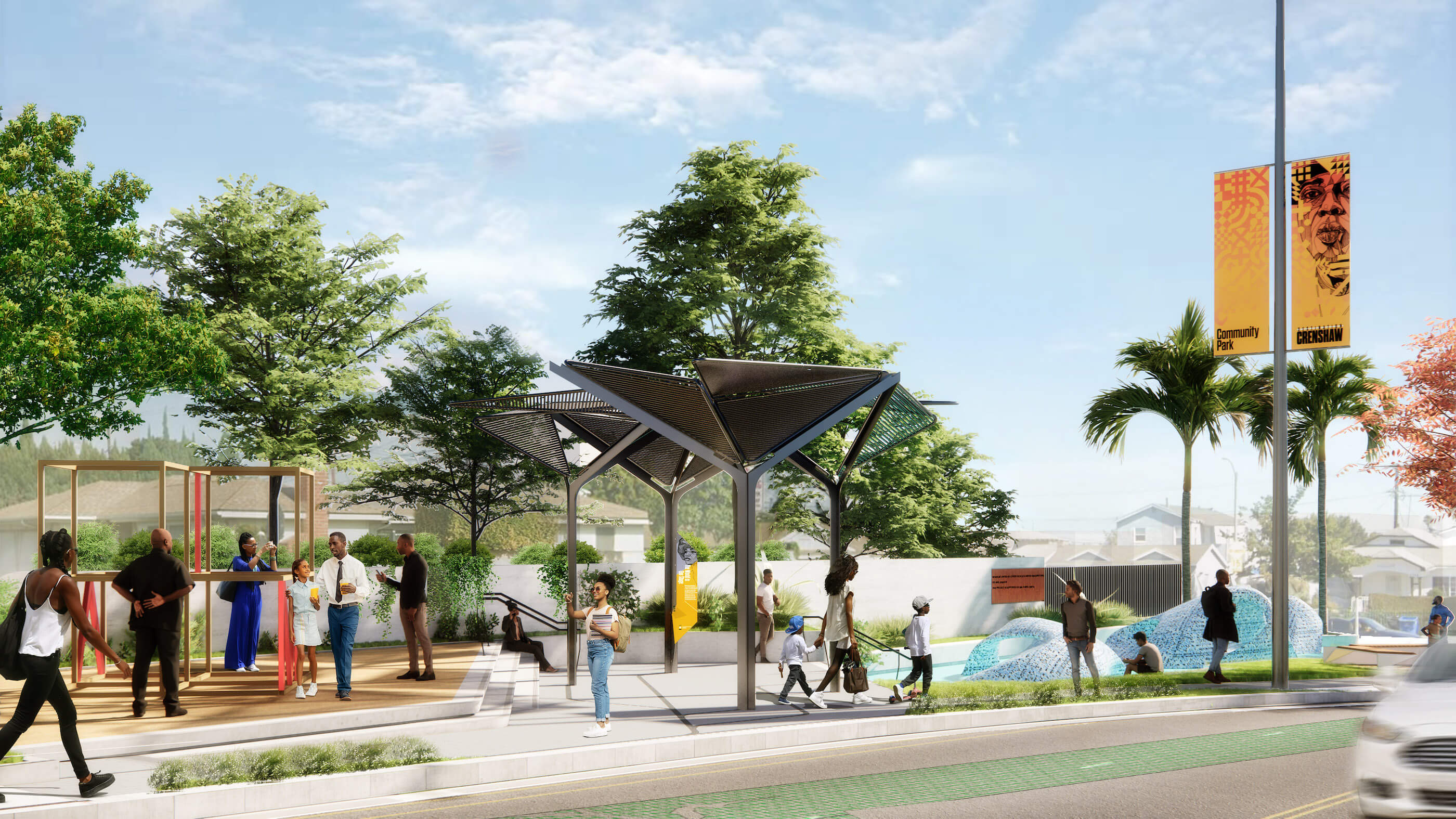
“After moving her home and studio to Crenshaw, a neighborhood she visited as a child when she was growing up in Riverside, Brenna Youngblood revisited an existing sculpture, MIA, to express the creativity, vitality, and innovation that grow out of a strong Black community where children have the opportunity to grow into the fullness of themselves. Fashioned to resemble large play blocks or a jungle gym, the sculpture reorders the letters MIA into I AM, asserting one’s own power to name and to know. The concept also recalls the 1968 sanitation workers’ strike in Memphis, the place of Dr. Martin Luther King, Jr.’s last campaign, where protestors marched with placards declaring I AM A MAN: a rallying cry of the Civil Rights struggle and other resistance movements in which people have demanded to be seen as human beings with agency.”











